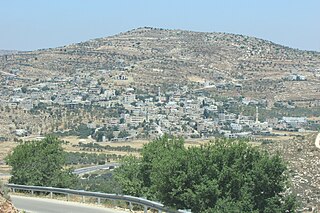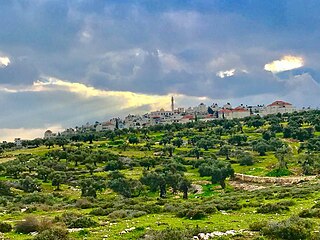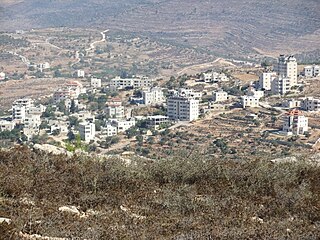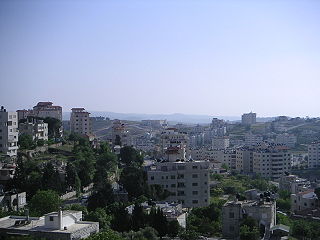
Ofra is an Israeli settlement located in the northern Israeli-occupied West Bank. Located on the main road between Jerusalem and Nablus, it falls under the jurisdiction of Mateh Binyamin Regional Council. In 2022 it had a population of 3,497.

Turmus Ayya is a Palestinian town located in the Ramallah and al-Bireh Governorate in the West Bank, in Palestine. According to the Palestinian Central Bureau of Statistics (PCBS), it had a population of 2,464 in 2017. A large percentage of the residents are Palestinian binationals with US citizenship.

Ein Yabrud is a Palestinian town in the Ramallah and al-Bireh Governorate in the central West Bank. It is located approximately 7 km northeast of the city of Ramallah and its elevation is 800 m. According to the Palestinian Central Bureau of Statistics (PCBS) the town had a population of 2,515 in 2017.

Ni'lin is a Palestinian town in the Ramallah and al-Bireh Governorate of the State of Palestine, in the central West Bank, located 17 kilometers (11 mi) west of Ramallah. Ni'lin is about 3 kilometers (1.9 mi) east of the 1949 Armistice Line bordered by Deir Qaddis, the Israeli settlements of Nili and Na'ale to the northeast, the village of al-Midya and Modi'in Illit settlement bloc are to the south, Budrus (4 km) and Qibya (5 km) villages are located to the northwest. The town's total land area consists of approximately 15,000 dunams of which 660 is urban. Under the Oslo II agreement, 93% of town lands has been classed as 'Area C'.

Al-Lubban ash-Sharqiya is a Palestinian village in the northern West Bank, 20 kilometers south of Nablus, in the Nablus Governorate of the State of Palestine. The town has a total land area of 12,075 dunams of which 200 dunams is built-up area. The village is just north of the historic Khan al-Lubban caravansary.

'Atara is a Palestinian village in the Ramallah and al-Bireh Governorate, located 15 kilometers north of Ramallah in the central West Bank. It is situated along a mountain ridge line with four peaks and is built upon the second highest point in the West Bank at 810 meters above sea level. 'Atara's total land area consists of 9,545 dunams, most of which is cultivable.

Deir Jarir is a Palestinian town in the Ramallah and al-Bireh Governorate in the central West Bank, located twelve kilometers northeast of Ramallah. It is situated on a hilltop overlooking the Jordan Valley at an elevation of 900 metres. According to the Palestinian Central Bureau of Statistics (PCBS), Deir Jarir had a population of 4,469 inhabitants in 2017.

Rammun is a Palestinian town in the Ramallah and al-Bireh Governorate in the central West Bank, located twelve kilometers east of Ramallah and three kilometers south of Taybeh. Other nearby towns include Deir Dibwan to the southwest, Beitin to the east and Ein Yabrud to the northeast.

Dura al-Qar' or Dura al-Qari'a is a Palestinian town in the central West Bank, part of the Ramallah and al-Bireh Governorate. According to the Palestinian Central Bureau of Statistics, Dura al-Qar' had a population of 3,032 inhabitants in 2017.

Kharbatha al-Misbah is a Palestinian town in the central West Bank, located 12.5 kilometers (7.8 mi) west of Ramallah in the Ramallah and al-Bireh Governorate. According to the Palestinian Central Bureau of Statistics, the town had a population of 6,366 in 2017. It has a total land area of 4,431 dunams, of which 644 are built-up areas and the remainder agricultural lands and forests.

Beit Liqya is a Palestinian town located in the Ramallah and al-Bireh Governorate in the northern West Bank. According to the Palestinian Central Bureau of Statistics, it had a population of approximately 9,304 in 2017.

Urif is a Palestinian village in the Nablus Governorate of the State of Palestine, in the northern West Bank, located 13 kilometers south of Nablus. According to the Palestinian Central Bureau of Statistics (PCBS), the town had a population of 3,624 inhabitants in 2017.

Kafr Malik is a Palestinian town in the Ramallah and al-Bireh Governorate of the State of Palestine, located 17 kilometers Northeast of Ramallah in the northern West Bank. According to the Palestinian Central Bureau of Statistics (PCBS), the town had a population of 2,946 inhabitants in 2017.

al-Mughayyir is a Palestinian village in the Ramallah and al-Bireh Governorate, located 27 kilometers Northeast of Ramallah and 34 kilometers Southeast of Nablus, in the northern West Bank. According to the Palestinian Central Bureau of Statistics (PCBS), the village had a population of 2,872 inhabitants in 2017.

Budrus is a Palestinian village in the Ramallah and al-Bireh Governorate, located 31 kilometers northwest of Ramallah in the northern West Bank. According to the Palestinian Central Bureau of Statistics (PCBS), the village had a population of 1,596 inhabitants in 2017.

Nabi Salih is a small Palestinian village in the Ramallah and al-Bireh Governorate in the central West Bank, located 20 kilometers northwest of Ramallah. It had a population of 522 in 2017. In 2010-2016 weekly protest marches were organized by the villagers to fight against the occupation of the West Bank. According to data compiled by Mondoweiss, 350 villagers were injured in clashes with Israeli troops during this time.

Ein Siniya is a small Palestinian village in the Ramallah and al-Bireh Governorate, 10 kilometers (6.2 mi) north of Ramallah, and approximately 1km northeast from Jifna. It lies in a valley surrounded with olive and fig-terraces.

Yabrud is a Palestinian village in the Ramallah and al-Bireh Governorate in the central West Bank. It is located approximately 13 km northeast of the city of Ramallah and its elevation is 790 m. According to the Palestinian Central Bureau of Statistics (PCBS) 2017 census, the town had a population of 575.
Jibiya is a Palestinian village in the Ramallah and al-Bireh Governorate. It was founded after the 16th century. It is mentioned in text from 1697.

Jiljilyya is a Palestinian village in the Ramallah and al-Bireh Governorate in the northern West Bank.





















